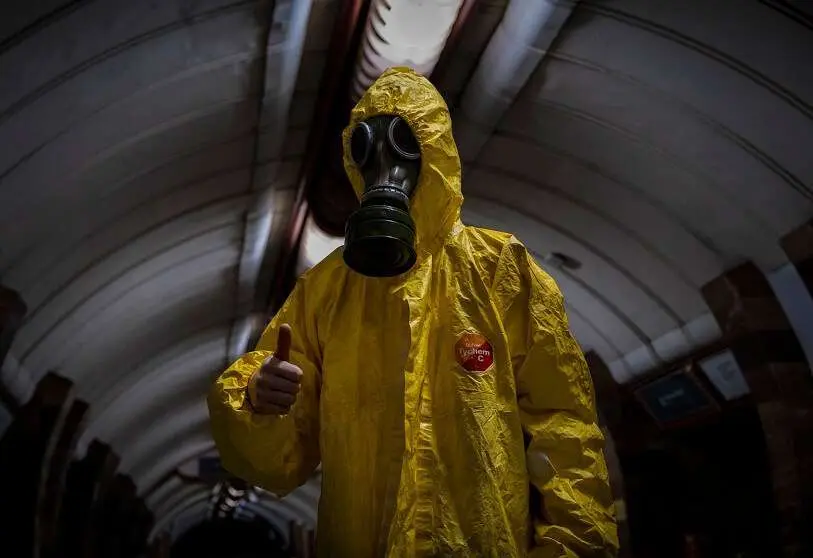Kharkov, the city that lives underground

Dima celebrated her first birthday at the Alekseevka metro station. He blew out a candle on a piece of cake, oblivious to the reality of the war on the city's surface. He is too small to notice.
Along with Dima, another 300 people live permanently in this station, but on nights when the shelling is at its heaviest, up to 500 souls can be crammed onto the platforms, down the stairs and even by the turnstiles. 500 people in a single metro station... and in Kharkov there are thirty stations.
This is the reality in which this city, Ukraine's second largest, has been living since the war began. Its proximity to Russia, with which it shares a border, has turned the region into one of the most dangerous places to live.

In the past three months, more than 500 civilians have been killed in the shelling of Kharkov, and nearly a million have been evacuated. Those holding out in the city - about 30 per cent of its usual population - have been living underground for longer than above ground.
In addition to metro stations, thousands of buildings in Ukraine have air-raid shelters. Virtually all those built in Soviet times, and not remodelled afterwards, have such 'anti-nuclear' basements. In most cases, they are damp, cold, unelectrified and poorly ventilated. But effective in case of bombing.
"There is no light, but there are fleas," explains one of the residents of Pavlovo Polie, who shows Atalayar the shelter in his building. The floor is made of earth, and although they have put up cardboard, the dampness penetrates it. It's hard," he continues in a more serious tone, "the children sleep here too. All in the same shelter, sharing mattresses and blankets".

In the same street, another family invites us to see the space they have adapted as a shelter in their block of flats. It is also a basement, but it is well equipped. It has electricity, mattresses and even a small table with a microwave. But the space is insufficient for the 40 people who sleep there every night. Pets included.
Pavlovo Polie is a university neighbourhood, where there are no military installations or any critical infrastructure. But the artillery fire that Russian troops are firing indiscriminately on Kharkov, to "soften up" as they say in military jargon, has repeatedly landed here since February.

If the situation in the city centre is tough, what can be seen in the northern district of Kharkov is breathtaking. In Saltivka, Europe's largest dormitory town, only 5 percent of its residents are left. It is the most heavily bombed district in the region, and they no longer have electricity, light, gas or any other services.
There is no medical care, no fire service, no police. Only SWAT and the army now enter this neighbourhood where 80 percent of the buildings have been bombed. As a result, most of the residents who have remained there are surviving in cramped conditions in the various metro stations. And the conditions are truly appalling.
Unlike the stations in the centre, where everything seems to be well organised and basic services are provided, the platforms of the Saltivka subway are a chaos of mattresses, beds and even bunk beds that have to be negotiated in order to move forward. Ventilation is not good, and the air is too stuffy. And the drinking water has been taken from a tap under a tile.

The train carriages stranded on the tracks have also been turned into makeshift houses, where the residents of this neighbourhood accumulate the belongings they have salvaged from their homes.
There are no families with children, as in Alekseevka. But there are many people with reduced mobility and old people, many old people. And the food is not enough, despite the fact that a group of volunteers are risking their lives every day to bring it there. It hurts to see the conditions in which they live.
A week ago, Zelensky's Defence Ministry trumpeted Ukraine's military victory in Kharkov, but the shelling has not stopped in this region. This weekend, for example, a regional market and the Railway Hospital were both hit.
It is true that the Ukrainian armed forces have pushed the Russian troops back to the border itself, and have liberated dozens of occupied villages in the north, but most of them are no longer habitable because their houses, schools and hospitals have been reduced to rubble.

Every day, public workers are busy repairing the damage caused by the shelling, removing debris and patching the concrete of the roads where many of the rockets that fall on Kharkov hit. But it is estimated that 25 percent of the infrastructure is damaged to a greater or lesser extent, and more than 500 flat blocks have to be demolished.
Nevertheless, Kharkov is trying to return to normality, not least because thousands of residents are returning as the conflict is likely to drag on. And one of the measures announced by the region's governor, Oleg Sinegubov, is to resume the metro service. This would be normal, if it were not for the fact that the underground stations are home to around 5,000 people who no longer have a home to return to.








